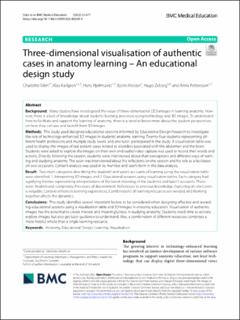| dc.contributor.author | Silén, Charlotte | |
| dc.contributor.author | Karlgren, Klas | |
| dc.contributor.author | Hjelmqvist, Hans | |
| dc.contributor.author | Meister, Björn | |
| dc.contributor.author | Zeberg, Hugo | |
| dc.contributor.author | Pettersson, Anna | |
| dc.date.accessioned | 2023-03-01T14:44:37Z | |
| dc.date.available | 2023-03-01T14:44:37Z | |
| dc.date.created | 2022-09-20T09:26:31Z | |
| dc.date.issued | 2022 | |
| dc.identifier.citation | BMC Medical Education. 2022, 22(1):477. | en_US |
| dc.identifier.issn | 1472-6920 | |
| dc.identifier.uri | https://hdl.handle.net/11250/3055085 | |
| dc.description.abstract | Background
Many studies have investigated the value of three-dimensional (3D) images in learning anatomy. However, there is a lack of knowledge about students learning processes using technology and 3D images. To understand how to facilitate and support the learning of anatomy, there is a need to know more about the student perspectives on how they can use and benefit from 3D images.
Methods
This study used designed educational sessions informed by Educational Design Research to investigate the role of technology-enhanced 3D images in students’ anatomy learning. Twenty-four students representing different health professions and multiple study levels, and one tutor, participated in the study. A visualisation table was used to display the images of real patient cases related to disorders associated with the abdomen and the brain. Students were asked to explore the images on their own and audio/video capture was used to record their words and actions. Directly following the session, students were interviewed about their perceptions and different ways of learning and studying anatomy. The tutor was interviewed about his reflections on the session and his role as a facilitator on two occasions. Content analysis was used in its manifest and latent form in the data analysis.
Result
Two main categories describing the students’ and tutor’s accounts of learning using the visualisation table were identified: 1. Interpreting 3D images and 2. Educational sessions using visualisation tables. Each category had signifying themes representing interpretations of the latent meaning of the students' and tutor's accounts. These were: Realism and complexity; Processes of discernment; References to previous knowledge; Exploring on one's own is valuable; Context enhances learning experiences; Combinations of learning resources are needed and Working together affects the dynamics.
Conclusions
This study identifies several important factors to be considered when designing effective and rewarding educational sessions using a visualization table and 3D images in anatomy education. Visualisation of authentic images has the potential to create interest and meaningfulness in studying anatomy. Students need time to actively explore images but also get tutor guidance to understand. Also, a combination of different resources comprises a more helpful whole than a single learning resource. | en_US |
| dc.language.iso | eng | en_US |
| dc.publisher | BMC | en_US |
| dc.rights | Navngivelse 4.0 Internasjonal | * |
| dc.rights.uri | http://creativecommons.org/licenses/by/4.0/deed.no | * |
| dc.title | Three-dimensional visualisation of authentic cases in anatomy learning – An educational design study | en_US |
| dc.type | Peer reviewed | en_US |
| dc.type | Journal article | en_US |
| dc.description.version | publishedVersion | en_US |
| dc.rights.holder | © The Author(s) 2022. | en_US |
| dc.source.pagenumber | 14 | en_US |
| dc.source.volume | 22 | en_US |
| dc.source.journal | BMC Medical Education | en_US |
| dc.source.issue | 1 | en_US |
| dc.identifier.doi | 10.1186/s12909-022-03539-9 | |
| dc.identifier.cristin | 2053336 | |
| dc.source.articlenumber | 477 | en_US |
| cristin.ispublished | true | |
| cristin.fulltext | original | |
| cristin.qualitycode | 1 | |

